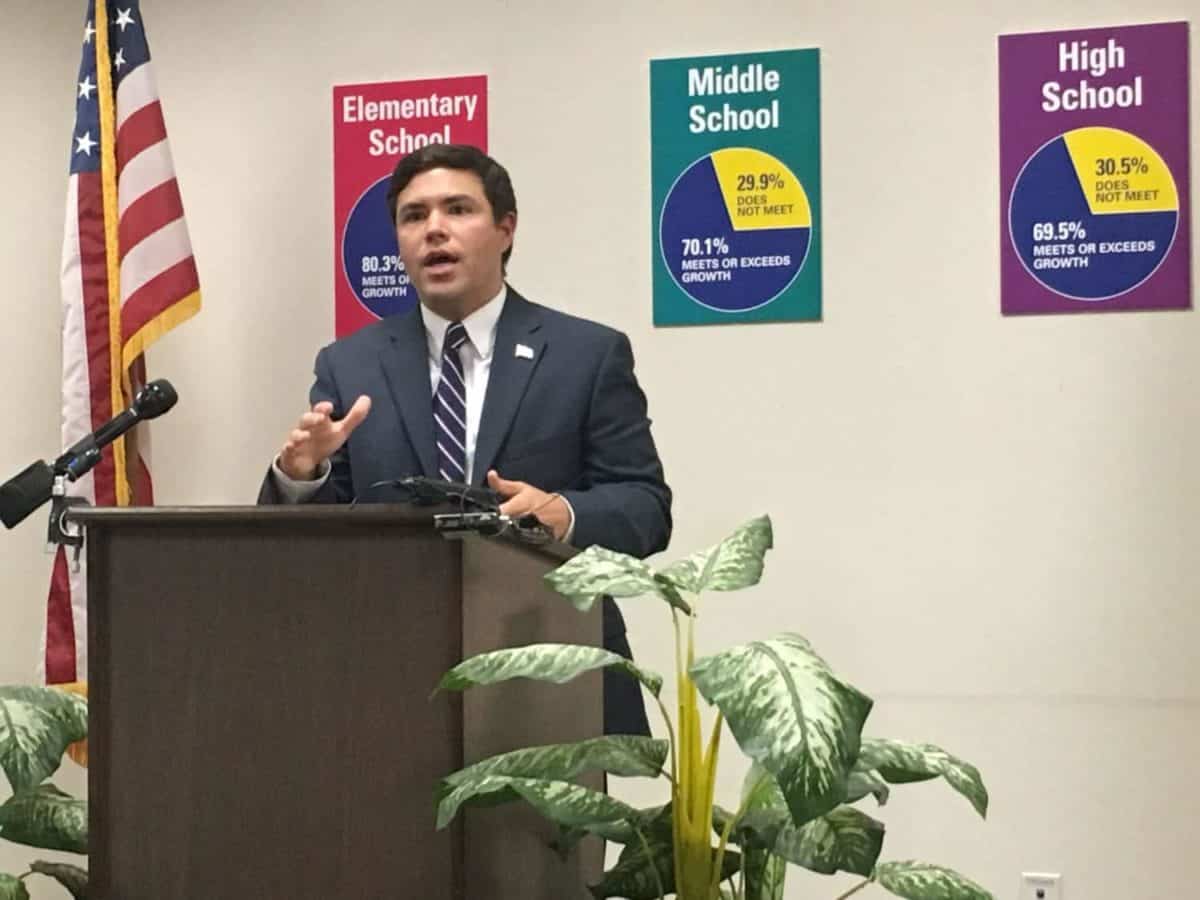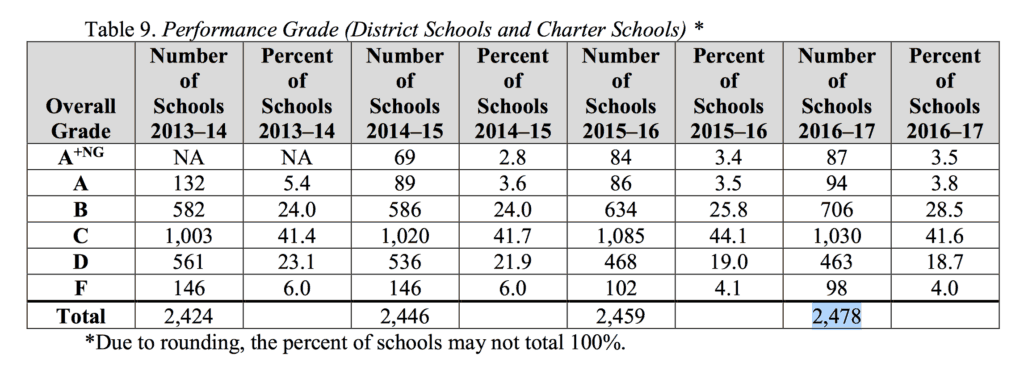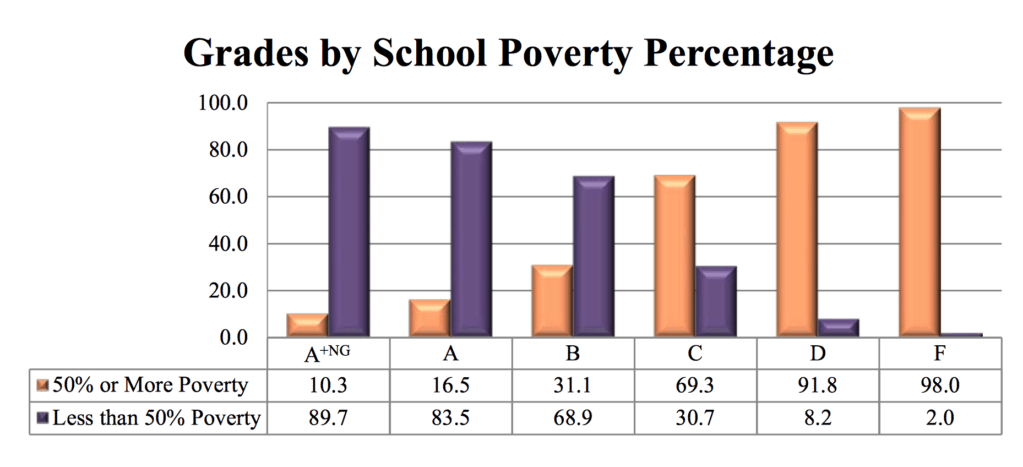
The State Board of Education received good and bad news when they heard data on the latest release of the School Performance Grades yesterday.
The number of As and Bs received by the 2,478 schools measured in the release increased, while the number of Ds and Fs decreased. However, the number of schools and districts that qualify as low performing increased since the 2015-16 school year.
“It’s great news that the top-line trends are in the right direction. We can all be proud, for instance, that most schools meet or exceed growth,” Superintendent Mark Johnson said during the press conference and in a press release. “But deeper into the data, the results show stubborn concerns that call out for innovative approaches. It is with innovation and personalized learning that we can transform incremental progress into generalized success.”
Most schools in North Carolina either met or exceeded growth in 2016-17 according to the data.

The chart below shows how schools fared in growth as compared to the prior year.

The number and percent of schools that exceeded expected growth decreased slightly while the number and percent of schools that met expected growth increased slightly. The number and percent that did not meet growth is about the same. It is important to note that there are more schools in the 2016-17 school year than in the 2015-16 school year.
The state has graded schools on a 15-point grading scale since 2015. The grades are calculated by using a formula that mixes 80 percent academic achievement with 20 percent academic growth.
Below is a chart showing the breakdown of the school performance grade by number, percentage, and when compared to previous years. The designation A+NG signifies schools that get an A and do not have large achievement or graduation gaps.
About 7.3 percent of all schools have either an A or A+NG. These numbers are up consistently from the prior years of the report. About 28.5 percent got Bs, which is also up from the previous years. Forty-one point six percent received Cs, which is down from all but the first year of the school performance grade release. Eighteen point seven percent received Ds, which is also down from all previous years, as is the 4 percent who received Fs.

In previous years, the release of the school performance grades have mirrored pretty closely the state of poverty of many of the students in state’s schools. The students in schools that get Ds or Fs consistently are some of the poorest, and that continues to be the case in the latest release.

According to the state’s press release, 92.9 percent of the schools that received Ds or Fs had at least 50 percent of students from low-income families.
State Board member Reginald Kenan noted this fact during the board meeting. “It’s common sense,” he said. “With poverty, it’s the kids who suffer most.”
At the press conference, Johnson said innovations and personalized learning, as well as programs like the Innovative School District, will hopefully help stem the tide of low performance amongst schools with large population of low-income students.

More schools and districts are low performing under the recent release of the School Performance Grades as well.
Low-performing schools are those that receive a D or F and either meet or do not meet the state’s academic growth standards. Low-performing districts are districts where the majority of the schools are low performing.
The number of low-performing schools increased by 16 schools, while the number of low-performing districts increased by one. The number of recurring low-performing schools increased by 53.
“We do see an increase, but that’s not the whole story, so I do want to share with you the rest of the story,” Nancy Barbour, the state Department of Public Instruction’s (DPI) director of District and School Transformation, told the State Board. She went on to say that some of the schools that were previously low performing no longer are, and some that previously were not have moved onto the list. Her division works with districts that are considered low performing to help them improve and ultimately move beyond the designation.
Mark Jewell, president of the North Carolina Association of Educators, released a statement Thursday tying the school performance grades to what he sees as the failure of education policy in the state.
“The school letter grades released today are a stark reminder that the resources our students need to be successful have been continually disregarded and the failure to address poverty’s impact on student achievement is real. Instead of going through this A-F labeling exercise each year, we should be focusing on modern textbooks and technology, adequate classroom supplies, putting more educators in our school buildings and paying them as professionals,” he said. “Our educators are doing tremendous work in some of the most difficult circumstances. We should give them and our students the resources they need to be successful, instead of a punitive grading system and a reliance on high stakes testing.”
Along with the School Performance Grades, the state also released a host of other data points related to the state’s schools, including graduation rates. The state reached an all-time high with 86.5 percent of students graduating from high school in four years or less. The statistic is an increase of 18.2 points since 2006.
Johnson noted, however, State Board concerns that while the graduation rate is high, many students are graduating without being considered college-and-career ready. He emphasized growth scores during the press conference.
“We are proud of the graduation rate, but it’s not the only metric to judge schools by,” he said. “Growth is a very important indicator that we want our principals and teachers to know we take very seriously.”
House Speaker Tim Moore, R-Cleveland, weighed in on both the school performance grades and graduation rate in a press release.
“North Carolina’s school system continues to deliver a learning environment that encourages success and workplace preparedness for students. With more and more students graduating each year we know that incremental policy changes continue to have a positive impact for our students,” Moore said. “With our student graduation rate now at 86.5 percent we will need to really focus our efforts to ensure student achievement can continue to rise in North Carolina. We look forward to continuing our work with Superintendent Mark Johnson to identify additional innovations to reduce achievement gaps across the state.”
Innovative School District
Eric Hall, superintendent of the Innovative School District, unveiled to the State Board yesterday a list of schools that could qualify to join the district.
The Achievement School District bill was passed during the 2016 General Assembly short session. At the heart of the legislation is the creation of a district that will include five low-performing schools from around the state. The schools could be turned over to for-profit charter operators.
The legislation establishing ASDs also gave districts that participate the opportunity to pick up to three other low-performing schools in their districts to join an Innovation Zone. Schools in this zone would have charter-like flexibility but would continue to be managed by the school district.
The recently passed budget tweaked the ASD program slightly, changing its name to the North Carolina Innovative School District (ISD). It also added a provision that says if a district participating in the ISD has more than 35 percent of its schools identified as low-performing, then all of those schools could become part of an Innovation Zone should the district elect that option.
Forty-eight schools from 21 districts made the list of possible schools. Hall hopes to bring the name of two schools to the board next month, and his plan is for those schools to start operating next school year.
“Today is really a big day,” he told the State Board. “It marks the first step towards the full implementation of the innovative school district.”
He added in a press release: “These schools represent school districts from across the state that can benefit from the diverse strategies and interventions made available by the NC Innovative School District. Once the school selection process is complete, we will be partnering with local communities and districts to examine how we can together create innovative conditions that will help students to improve their academic achievement.”
According to the press release, the criteria for the schools on the list were as followed:
- A performance score in the lowest 5 percent of all schools in the prior year.
- Offers all or part of grades K-5.
- Did not exceed growth in at least one of the prior three school years and did not meet growth in at least one of the prior three school years.
- Did not adopt one of the established reform models for the immediate prior year.
Durham Public Schools, Forsyth County Schools, and Robeson County Schools had high number of schools represented on the list, shown below. The full list is available here.


ESSA
The State Board approved North Carolina’s Every Student Succeeds Act (ESSA) plan Thursday, with all members voting in favor of the plan except Vice Chair Buddy Collins. Although the plan passed, it raised concerns from members of the board during discussion on Wednesday.
Despite the board’s criticisms of the plan’s accountability system and lack of stakeholder input last month, Superintendent Johnson began the discussion with confidence that the document was ready for approval.
“I am happy to say that, based on our discussion and follow-up by staff in this department, that those concerns are largely behind us,” Johnson said. “Following the (August) meeting, we communicated with board members to ensure that we had addressed all the comments of this board.”
DPI must send the plan to the U.S. Department of Education by Sept. 18, after the governor approves it. The federal department has 120 days to review the plan and either approve or reject it, with the option to request changes. States have 15 days to make those changes.
ESSA, which replaced No Child Left Behind, gave individual states flexibility in developing their statewide plans. DPI officials and board members met with educators and community members for more than a year to hear their ideas, but the General Assembly mandated much of North Carolina’s specifics in its final budget passed this summer. Board members expressed frustration because the plan sticks with familiar testing and accountability models.
“I’m disappointed that we did not take the opportunity to reform testing,” Collins said. “We spent a lot of time lobbying in Washington to give testing flexibility to the state, and, in my estimation, our testing that we will be doing is the same testing we’ve been doing.”
North Carolina Teacher of the Year Lisa Godwin, who serves as an advisor to the Board, said kindergarteners started mClass testing, a required reading assessment, Wednesday. Five-year-old students will be assigned colors based on proficiency in the coming weeks, she said, adding that teachers lack instructional time because of overbearing testing requirements.
“I’m reminded of the saying, ‘To grow the elephant, you don’t weigh it, you feed it,’ and I do feel like we’re weighing the elephant,” Godwin said.
Educators emphasized a need for success indicators other than testing throughout the last year, calling for measures that reflect school climate and do not strictly correlate with poverty. Chronic absenteeism was one of the predictors Board member Olivia Oxendine hoped would be included in the state’s accountability system. She said Governor Roy Cooper’s office said the indicator will be included in the school report card system instead of the ESSA plan.
“Maybe, in the report card, that will keep it in front of us,” Oxendine said. “I’m not saying that ESSA won’t be in front of us from year to year, but we know the report card will be in front of us. It will come to our attention on an annual basis. So that might be a better location for chronic absenteeism.”
Lou Fabrizio, DPI’s director of data, research, and federal policy, added language to the plan to reflect the Board’s interest in continuing conversations around creative approaches to accountability.
Fabrizio explained the specific changes made in the plan since the last draft and emphasized the Board’s ability to change the plan down the road.
“After the plan is approved, the State Board has the authority, with the State Superintendent, of making recommended changes a year from now, two years from now, whenever the need arises that there should be a change to the plan,” Fabrizio said.
Board member Eric Davis said he thinks the Board will need that amendment capability. He said the entire system needs more support and funding before progress can be made.
“Just to take Ms. Godwin’s analogy one step further, I don’t think we’re just weighing the elephant; I think we’re starving the elephant,” Davis said. “And we’re not going to achieve the goals of this plan, even as unaggressive as some may consider them to be, until we start feeding, in a greater way, our public school system, and our public school students.”



